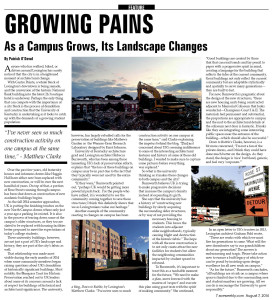By Patrick O’Dowd
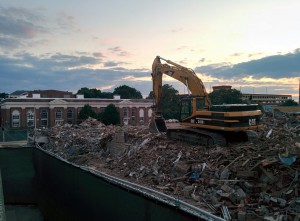
Anyone who has walked, biked, or driven around Lexington has surely noticed that the city is in a heightened moment of architectural change.
With Centre Pointe, a whole block of Lexington’s downtown is being remade, and the conversion of the historic National Bank building into the latest 21c boutique hotel is underway. Perhaps the only thing that can compete with the importance of a city block is the process of demolition and construction that the University of Kentucky is undertaking as it looks to catch up with the demands of a growing student population.
Over the past few years, old fraternity houses and infamous dorms like Haggin Hall have either now been replaced with new construction, or will be over the next handful of years. On top of that, a portion of Rose Street running through campus has been shut down as construction of new academic buildings begins.
As the fall 2014 semester approaches, UK is putting the finishing touches on the new North Campus dorms where only just a year ago a parking lot existed. It is also in the process of tearing down some of the campus’s older structures, as they too are slated to be replaced with housing facilities better prepared to meet the expectations of today’s college students.
These university buildings, however, are not just a part of UK’s landscape and history, they are part of the city’s fabric as well.
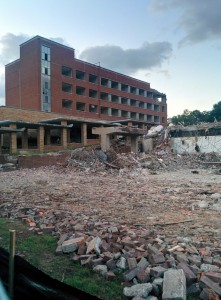
That relationship was made most visible during the early months of 2014 when some community members began raising questions about UK’s demolition of historically significant buildings. Most notably, the Bluegrass Trust for Historic Preservation reached out to UK leaders about some of its concerns around a lack of respect for buildings of historical and architectural significance. The university, however, has largely rebuffed calls for the preservation of buildings like Mathews Garden or the Wenner-Gren Research Laboratory designed by Ernst Johnson.
University of Kentucky architecture grad and Lexington architect Rebecca Burnworth, who has been among those lamenting UK’s lack of preservation efforts, explains that “the loss of these buildings on campus may be in part due to the fact that they typically were not used by the entire community.”
“If they were,” Burnworth pointed out, “perhaps UK would be getting more powerful push back. For the people who have rallied, it is wonderful to see the community coming together to save these structures; I think this definitely shows that we as Lexingtonians value our heritage.”
Another example of the community reacting to changes on campus has been a blog, Down to Rubble, by Lexington’s Matthew Clarke. “I’ve never seen so much construction activity on one campus at the same time,” said Clarke explaining the impetus behind the blog. “[I’m] just concerned about UK’s seeming indifference to some of the interesting architectural features and history of some of these old buildings. I wanted to make sure to capture some pictures before everything was replaced.”
So what is the university thinking as it makes these changes to both campus and the city?
Burnworth believes UK is trying to make progressive decisions that increase the campus’s density instead of expanding its girth.
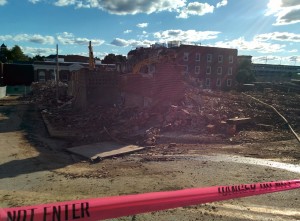
She says that the university has a history of “constructing new buildings by slowly acquiring the surrounding older structures, or by way of not providing the necessary housing to students. This forces the students into adjacent older neighborhoods, typically causing blight and destruction of the historic fabric.” The hope with all the new construction is to not only create attractive new facilities for students but allow the neighboring communities impacted by student sprawl to rebound.
To Burnworth, it’s important to treat this as a teachable moment for the future, “We need to make a plan, move forward with the mantra of ‘respect’ and execute this plan using great taste with the spirit of making community.” She continued, “Good buildings are created by those that that can read trends and lay pencil to paper with a progressive spirit in mind, creating a language for the building that reflects the tides of the current community. Great buildings not only reflect the current community but are adaptable stylistically and spatially to serve many generations—they are built to last.
For now, Burnworth is pragmatic about the design of the new structures, “there are new housing units being constructed adjacent to Memorial Coliseum that looks wonderful—Champions Court I & II. The materials feel permanent and substantial, the proportions are appropriate to campus and the nod to the architectural details of the coliseum next door is fantastic. It looks like they are integrating some interesting public spaces near the entrance of the building—which should also be successful.”
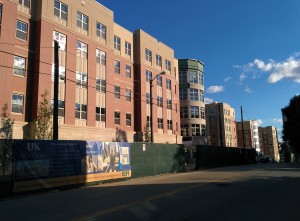
Down to Rubble’s Clarke, however, is a bit more concerned, “I’m not a fan of the private dorms, and I think they could have done much better on the design. As they stand, the design is ‘nice’ but bland, generic, and feel very ‘corporate.’”
In an open letter to UK’s trustees in 2013, Lexington architect Graham Pohl wrote, “These are works with which we must live for generations to come. What will the new dormitories say to our grandchildren about our generation? The answer is embarrassing and tragic. Please take action now to ensure a built legacy of which we can be proud by insisting upon design excellence for all new work on campus.”
“As for the future,” Burnworth concludes, “all buildings are at risk on a campus where space is limited due to the surrounding area and student numbers are growing. All we can do is encourage the University to grow responsibly.”
This article also appears on page 7 of the August 7, 2014 print issue of Ace.
Subscribe to the Ace e-dition for Lexington news, arts, culture, and entertainment, delivered to your inbox every Thursday morning.



